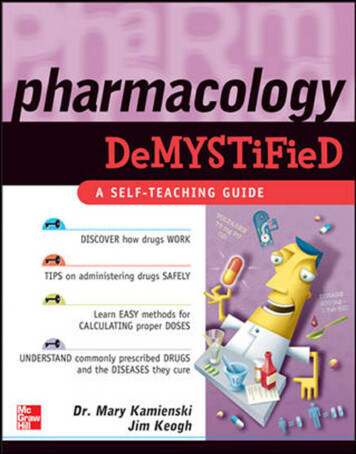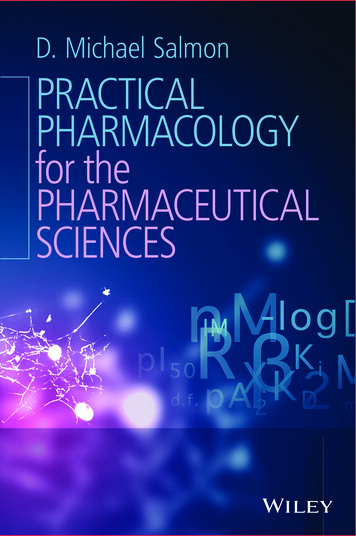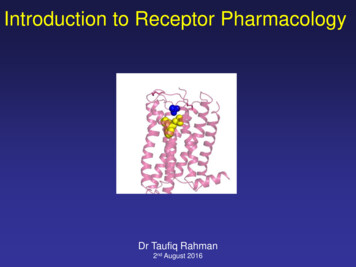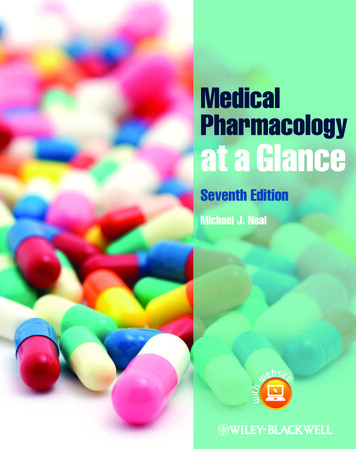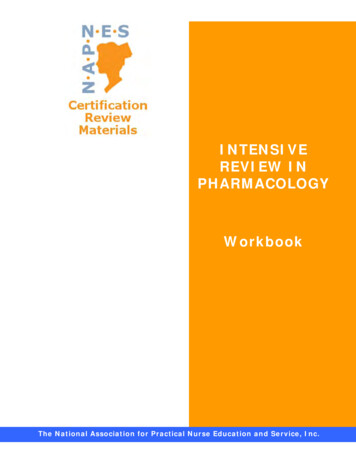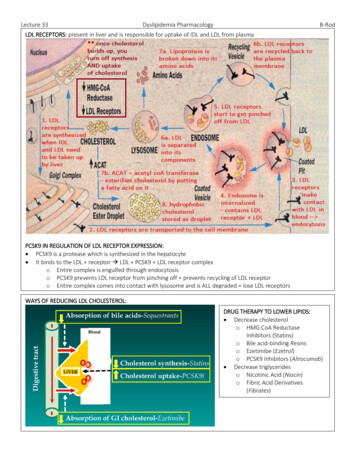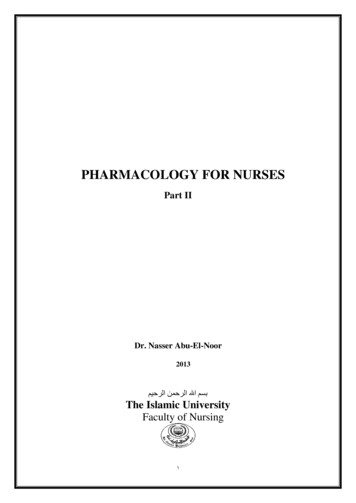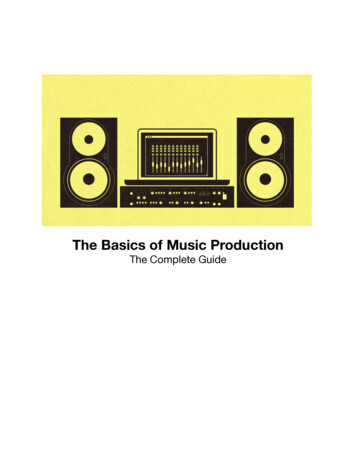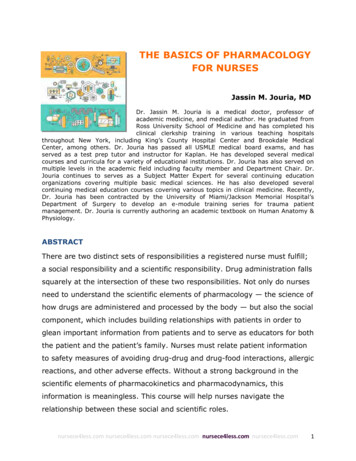
Transcription
THE BASICS OF PHARMACOLOGYFOR NURSESJassin M. Jouria, MDDr. Jassin M. Jouria is a medical doctor, professor ofacademic medicine, and medical author. He graduated fromRoss University School of Medicine and has completed hisclinical clerkship training in various teaching hospitalsthroughout New York, including King’s County Hospital Center and Brookdale MedicalCenter, among others. Dr. Jouria has passed all USMLE medical board exams, and hasserved as a test prep tutor and instructor for Kaplan. He has developed several medicalcourses and curricula for a variety of educational institutions. Dr. Jouria has also served onmultiple levels in the academic field including faculty member and Department Chair. Dr.Jouria continues to serves as a Subject Matter Expert for several continuing educationorganizations covering multiple basic medical sciences. He has also developed severalcontinuing medical education courses covering various topics in clinical medicine. Recently,Dr. Jouria has been contracted by the University of Miami/Jackson Memorial Hospital’sDepartment of Surgery to develop an e-module training series for trauma patientmanagement. Dr. Jouria is currently authoring an academic textbook on Human Anatomy &Physiology.ABSTRACTThere are two distinct sets of responsibilities a registered nurse must fulfill;a social responsibility and a scientific responsibility. Drug administration fallssquarely at the intersection of these two responsibilities. Not only do nursesneed to understand the scientific elements of pharmacology — the science ofhow drugs are administered and processed by the body — but also the socialcomponent, which includes building relationships with patients in order toglean important information from patients and to serve as educators for boththe patient and the patient’s family. Nurses must relate patient informationto safety measures of avoiding drug-drug and drug-food interactions, allergicreactions, and other adverse effects. Without a strong background in thescientific elements of pharmacokinetics and pharmacodynamics, thisinformation is meaningless. This course will help nurses navigate therelationship between these social and scientific roles.nursece4less.com nursece4less.com nursece4less.com nursece4less.com nursece4less.com1
Continuing Nursing Education Course PlannersWilliam A. Cook, PhD, Director, Douglas Lawrence, MA, Webmaster,Susan DePasquale, MSN, FPMHNP-BC, Lead Nurse PlannerPolicy StatementThis activity has been planned and implemented in accordance with thepolicies of NurseCe4Less.com and the continuing nursing educationrequirements of the American Nurses Credentialing Center's Commission onAccreditation for registered nurses. It is the policy of NurseCe4Less.com toensure objectivity, transparency, and best practice in clinical education forall continuing nursing education (CNE) activities.Continuing Education Credit DesignationThis educational activity is credited for 6 hours. Nurses may only claim creditcommensurate with the credit awarded for completion of this course activity.Pharmacology content is 6 hours.Statement of Learning NeedPharmacology continuous learning has become a highly satisfying methodfor nurses to increase and maintain proficiency in medication administration.Pharmacology learning tools, online or self-study, tailored to nursingknowledge needs are expected to lead to improved sharing of expertise andcollaborative practice throughout all levels of acute and outpatient healthcare settings.nursece4less.com nursece4less.com nursece4less.com nursece4less.com nursece4less.com2
Course PurposeThis course will provide learning for nurses at all levels of experience in basicpharmacology to help them develop knowledge of medication categories andimprove medication administration skills.Target AudienceAdvanced Practice Registered Nurses and Registered Nurses(Interdisciplinary Health Team Members, including Vocational Nurses andMedical Assistants may obtain a Certificate of Completion)Course Author & Planning Team Conflict of Interest DisclosuresJassin M. Jouria, MD, William S. Cook, PhD, Douglas Lawrence, MASusan DePasquale, MSN, FPMHNP-BC - all have no disclosuresAcknowledgement of Commercial SupportThere is no commercial support for this course.Activity Review InformationReviewed by Susan DePasquale, MSN, FPMHNP-BCRelease Date: 4/16/2016Termination Date: 4/16/2017Please take time to complete a self-assessment of knowledge, onpage 4, sample questions before reading the article.Opportunity to complete a self-assessment of knowledge learnedwill be provided at the end of the course.nursece4less.com nursece4less.com nursece4less.com nursece4less.com nursece4less.com3
1. The process of drug absorption, distribution in the body,metabolism and excretion is rapeutic pharmacologyPharmacogenomics2. The relationship determined by a drugs concentration and timeat the preferred action site, along with the drug's effects, boththerapeutic and adverse, are referred to utic pharmacologyPharmacogenomics3. The deciding factor in choosing which medication may be amore effective treatment for a patient is the drug with an EC50that has:a.b.c.d.A higher EC50A lower EC50The EC50 has no impact on this type of decision.The EC50 is the same for both drugs4. Therapeutic levels of a drug:a.b.c.d.Are best monitored with tissue samplesCannot cause toxicityAre not altered by diversity of medical conditionsGive the best medication therapy with minimized side effects5. Causes for variability in blood concentration of drugs are all ofthe following EXCEPT:a.b.c.d.Changes in absorption due to diet, exerciseDecreased availability of receptorsDisease processes limiting drug excretionSite of drug therapy is improvednursece4less.com nursece4less.com nursece4less.com nursece4less.com nursece4less.com4
IntroductionThere are two distinct sets of responsibilities that a registered nurse mustfulfill - a social responsibility and a scientific responsibility. Drugadministration falls squarely at the intersection of these two responsibilities.Not only do nurses need to understand the scientific elements ofpharmacology but also the social component. Nurses need to buildrelationships in order to glean important information from their patients andserve as educators for both the patient and the patient’s family. Amedication suitable for one patient might not necessarily be suitable toanother even if that patient is exhibiting a similar condition. The informationthat nurses obtain from their patients is critical for avoiding drug-druginteractions and drug-food interactions, allergic reactions, and other adverseeffects.Professional nurses need a strong background in the scientific aspects ofpharmacokinetics and pharmacodynamics. The importance of drugadministration and knowledge in the profession of modern nursing cannot beoveremphasized. The continuous study of drugs and their mechanisms ofaction (MOAs) provide nurses a number of benefits during the delivery ofpatient care. Pharmacology provides a comprehensive understanding withregard to drug usage and precautionary measures that need to beconsidered during the administration of different drugs so that the drugbenefits can be maximized and its harmful side effects minimized. Thiscourse includes helpful background and current information about basicpharmacology based on current resources, such as the Physician’s DeskReference, Lippincott Focus on Nursing Pharmacology, and StahlPsychopharmacology that are also conveniently available online. More thanever, nurses are able to access pharmacology resources through electronicnursece4less.com nursece4less.com nursece4less.com nursece4less.com nursece4less.com5
media that support safe and appropriate care at the time when it is mostneeded.Overview Of Pharmacology History And AdvancementDrugs are the most vital and extensively researched field of the medicalsciences. The advent of drugs started ages ago and health professionals nowhave a seemingly unlimited variety at their disposal. The rapid advancementin drugs has brought forward new cures, therapies and treatments for thediseases and medical conditions that had previously not been possible tocure. These are due to advancements in pharmacology - the study of actionsof drugs on living organisms. The healthcare team, which includes medicalproviders, nurses and other clinicians, does only need to be aware of oldermedications, but should also have knowledge of advancements that areoccurring and the way they affect the practice of medicine.As mentioned, the science of pharmacology has existed for millennia; andthe application and usage of pharmacologic products to relieve adverseconditions and suffering has become widely accepted in almost everycountry. Modern trends and advancement in medical science have greatlyenhanced pharmacology. Drugs have been a fundamental component of thetreatment of various diseases from the earliest existence of humankind,using various materials found in nature (i.e., tree bark, roots, herbs, animalparts, plant seeds, etc.). The MOA was unknown and, as such, usages ofthese substances were based solely on the observed therapeutic benefits orthe lack thereof. With the passage of time, through trial and error,knowledge of pharmaceuticals was developed to distinguish between harmfuland beneficial substances to be used as medicine. This section highlightsclassic discourse on pharmacology history and science.1nursece4less.com nursece4less.com nursece4less.com nursece4less.com nursece4less.com6
Modern pharmacology started in the mid 19th century through scientificstudy of the chemical separation of particular active agents from theircomplicated and complex mixtures, often plant extracts. It began withscientists predicting the impacts of medicine on the human patient. This ledto further investigations of the effects of specific agents on isolated organs.One of many examples of this development in modern pharmacology is thestudied effect of ergometrine on strips of uterine muscle.The origin of experimental pharmacology is usually linked with the work ofthe French physiologist, Francois Magendie, at the start of 19th century.Magendie’s research was based on strychnine-containing plants that clearlyestablished the action site of these substances. The sites of action were themotor neurons of the spinal cord. This work provided proof for the view thatpoisons and drugs must be dissolved in the blood and carried to the locationof action before generating their effects.The development and input of 20th century pharmacology have been huge,with more than twenty pharmacologists having won Nobel prizes. Theircontributions comprised of discoveries of numerous vital drugs, secondmessengers and neurotransmitters, and a more complete understanding ofmany biochemical and physiological processes. Pharmacology in general andthe growth of highly useful new drugs in particular has flourished during thepreceding half of the 20th century. This extraordinary development hasparalleled progress in associated disciplines upon which the field ofpharmacology builds and is built, such as the following disciplines: molecular biology biochemistry physiologynursece4less.com nursece4less.com nursece4less.com nursece4less.com nursece4less.com7
pathology anatomyThe growth of new analytical and investigational techniques and tools hasaided in the development of the following fundamental characteristics ofpharmacology. The association between dose and effect. Pharmacodynamics, which involves the events of ingestion, absorption,distribution, alteration and excretion of drugs. The localization of the action site. The mechanism of drug action. The association between biological action of substances and chemicalstructure.The past, present and future development of pharmacology aims to: Understand drugs and the way they affect living things. Know the accurate dosage of drugs. Identify and respond to drug interactions, reactions and side effectsand treat accordingly. Know when to apply drugs since some conditions do not require drugtherapy. Understand the procedure of drug ingestion, absorption, distribution,metabolism and removal. Identify the attributes of ideal drugs Know the implications of pharmacology in nursing, addressing thefollowing five ‘Right’ approaches:nursece4less.com nursece4less.com nursece4less.com nursece4less.com nursece4less.com8
1) Use right drug2) Give to the right patient3) Give the right dose4) Give by the right route5) Give at the right timeThe field of pharmacology has been divided broadly into two major classes ofpharmacokinetics and pharmacodynamics, which will be discussed in moredepth in the following sections.PharmacokineticsPharmacokinetics can be defined as the movement of drugs within thebody’s cells, tissues and organs. This process can be referred to as the(L)ADME scheme, which is explained below: Liberation:The process of drug release; this may apply, depending on the drugformulation and delivery system (i.e., is the drug enteric coated toincrease release in the small intestine versus the stomach). Absorption:The process of the diffusing or being actively transported into theblood and plasma. Distribution:Distribution involves the dissemination of the drug into the fluid spacesof the body (intracellular, extracellular, intracapsular, plasma).nursece4less.com nursece4less.com nursece4less.com nursece4less.com nursece4less.com9
Metabolism:This process is also known as biotransformation and is the biochemicalseries of processes used to alter the drug into its metabolites. Excretion:This is the removal of the drug and its metabolites from the bodyfluids.PharmacodynamicsPharmacodynamics can be defined as the effects and MOA of a drug on thebody’s cells, tissues and organs. This will be discussed in further depth lateron in this introductory section.Pha
Pharmacology provides a comprehensive understanding with regard to drug usage and precautionary measures that need to be considered during the administration of different drugs so that the drug benefits can be maximized and its harmful side effects minimized. This course includes helpful background and current information about basic pharmacology based on current resources, such as the .
